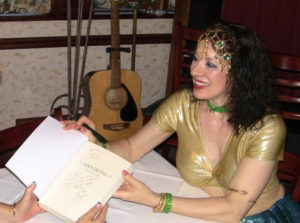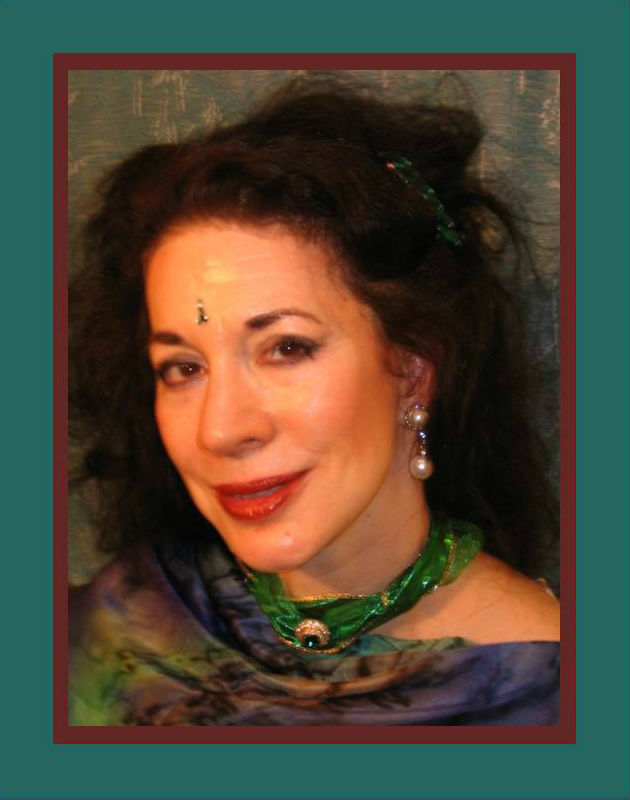Pre-Workshop Study: Dancing with a Long, Chiffon Silk Veil
We are so often too obvious. We run around in simple clothes that show all of who we are, all at once.
So often, when we watch dancers, we see them entering the stage with their veil behind them. They do a quick series of veil flourishes, then drop their veils and move on to the “main portion” of their dance.
Where is the mystery in this?
Today, we begin learning the Art of Mystery.
We don’t give it all away anymore.
Instead, we are worth waiting for.
Everything good comes in time, including the privilege of someone seeing us in our full glory.
The Music
Most of us use Spotify, so I’m going to do my best to assemble Spotify playlists for you.
There are two kinds of music with which we’ll experiment for the Art of Mystery; music where we want to be in a more reserved space.
- Chifti Tellis are a specific Turkish rhythm. They are very lush and sensual; perfect for veil dances – particularly for in-place veil moves. (Sometimes they are also good for movement across the floor.) See the previous blogpost for a good chifti telli link. Introduction to Veils: Framing Yourself Beautifully.
- Taxims – Taxim (sometimes taksim) literally means “solo improvisation,” and in Oriental dance circles, generally means a solo improv by a single dancer to improvisational music by a single musician; generally on an oud or wind instrument.
Chifti Telli Music
In a recent class, we experimented with framing different parts of our body (hips, rib cage, hips from a back angle, and diagonal-back view) using this music:
- Journey of Light, a chifti telli by Desert Wind on their Gaia, Earth Goddess: Ritual Dances CD: Journey of Light on Spotify.
Soulful Music – Good for Interpretive Veil Dancing
Our featured study piece for this workshop will be Sira’s dance; details below. She uses a song that is performed on the Armenian duduk. This music is actually a composed song, it’s not a taxim – but it is very soulful and heartfelt. Very good for veil dancing.
- Wishful Thinking by Raul Ferrando featuring Ararat Petrossian and Faisal Zedan on duduk (this is the music used by Sira in a beautiful dance in the YouTube Resources (below), and here’s the link to Wishful Thinking on Spotify.
- They Have Taken the One I Love – another exceptionally beautiful piece, Lévon Minassian (Duduk), and here’s a link to They Have Taken the One I Love on Spotify
Here’s another beautiful piece on the Armenian duduk (the name was not given, so I don’t have a Spotify link for it): Armenian duduk music; very emotional and haunting – good for an introspective taxim (solo improvisation) with veil.
Music Interpretation
When we work with a chifti telli, we can do fairly structured movements, because the chifti telli has a specific 8-count rhythm (slow, slow, fast, fast, fast, space – which is too much of a simplification, for the actual chifti telli count, listen at chifti telli rhythm explained and demonstrated). The movements are usually rounded instead of percussive, although we could throw in something with a little definitive crispness to it at the end of a motif. In working with a chifti telli, you might use your veil to frame different parts of your body (and costume). For example, with the Journey of Light piece mentioned above, I used a simple choreography that separately framed the hips, rib cage, hips from a back angle, and diagonal-back view. This particular piece also led easily into a touch-step walk.
In contrast, when we dance in a (solo improvisational) taxim, the last thing that we want to do is make it seem as though it’s pre-choreographed. Instead, we want to be flowing and interpretive, and (very often) in a more inner state – as opposed to being outgoing and audience-interactive.
Featured Study Piece
Sira, who has studied with Anahid Sofian as well as other New York City masters, performing a moving dance with a classic veil entrance – notice that she keeps herself covered for the first couple of minutes: Sira – Veil Belly dance to “Wishful Thinking”. The beautiful and haunting music is performed on the duduk, an Armenian wind instrument. Here’s a link to the music for Sira’s dance, which she says is by “Sol Shalapanova … it’s “Wishful Thinking” by Raul Ferrando featuring Ararat Petrossian and Faisal Zedan on duduk,” and here’s the link to Wishful Thinking on Spotify.
Pre-Workshop Study
The best way to get the greatest value from your workshop is to pre-prepare.
Anahid Sofian is one of the great proponents of dancing with a long silk chiffon veil. (Typically, 3 1/2 -4 yards, trimmed as needed – inch-by-inch – to the dancer’s ability to work with the veil. For dancers such as myself, at 5′ 4″, the 3 1/2 yards of silk chiffon is probably good. For dancers who are 5′ 6” or taller, Anahid recommends 4 yards.)
Sira has studied extensively with Anahid, so you’ll see elements of Anahid’s style in Sira’s dance.
A silk chiffon veil becomes an extension of the dancer – Anahid Sofian.
At the same time, another exceptional dancer is Eva Cernik, who is internationally recognized as a great and innovative artist. She has also studied extensively with Mdm. Sofian, as well as with other great – and worldwide – master teachers. Although Eva’s style is distinctly her own, we can trace the influence of Mdm. Sofian’s teachings. Eva typically uses a silk habotai (China silk) veil. Eva has described her veil as “dancing with a partner.”
This is a really interesting compare-and-contrast study, because both master dancers (Sira and Eva) trace their lineage to Mdm. Sofian. In the YouTube link above for Sira, and in the YouTube links for Anahid and Eva in Dancing with Your Veil: YouTube Resources, you can see three magnificent dancers, with two different kinds of veils – coming from the same tradition.
Study Questions
- What are your thoughts and feelings as you study the performances by these three masters? More specifically, if you can imagine yourself being Sira, or Anahid, or Eva, how would you feel as you danced?
- Does one kind of veil (silk chiffon or China silk) appeal to you more than another?
- What sorts of techniques and timing seem to work better with one kind of veil than another?
- How would draping yourself with the two different kinds of veils work for you?
- What kinds of movements could you do with the two different kinds of veil – both static (in-place) movements and movements across the floor?
Bring your notes (and questions / comments) to the workshop, and we’ll discuss during the lunch break.
Extra-special advanced study questions:
- How is Sira using dynamic tempo (fast slow, including pauses) to create more interest in her music? How do Anahid and Eva use variations in tempo?
- What are some of the different drapes that the dancers are using? How do these different drapes make you feel as an audience member? How would you feel differently as a dancer?
- When does Sira start removing her veil? (Actually, she’s less removing it, and more dancing with it.) Same questions, with regard to Anahid and Eva.
Suggested Reading
What was it that Anahid had, and that I had totally forgotten?
Simply, it was the power of holding something back.
Quote from: Unveiling: The Inner Journey, by Alay’nya; Chapter 26: Unveiling: Selective Revelation, p. 359

The whole notion of unveiling ourselves – slowly – is behind the book, Unveiling: The Inner Journey, which was published in 2011.
Very best wishes as you use Oriental dance (belly dance) for personal growth and healing!
Yours in dance –

Alay’nya
Author of Unveiling: The Inner Journey
You are the Jewel in the Heart of the Lotus. Become the Jewel!
Founder and Artistic Director, The Alay’nya Studio
Bellydance a courtesan would envy!
Check out Alay’nya’s YouTube Channel
Connect with Alay’nya on Facebook
Follow Unveiling: The Inner Journey on Facebook
|
Alay’nya, Unveiling: The Inner Journey |
||||
|
Paper
|
Kindle
|
|||
Copyright, 2018 (c). All rights reserved.
Related Posts: Veil Dancing
Copyright, 2018 (c). All rights reserved.

